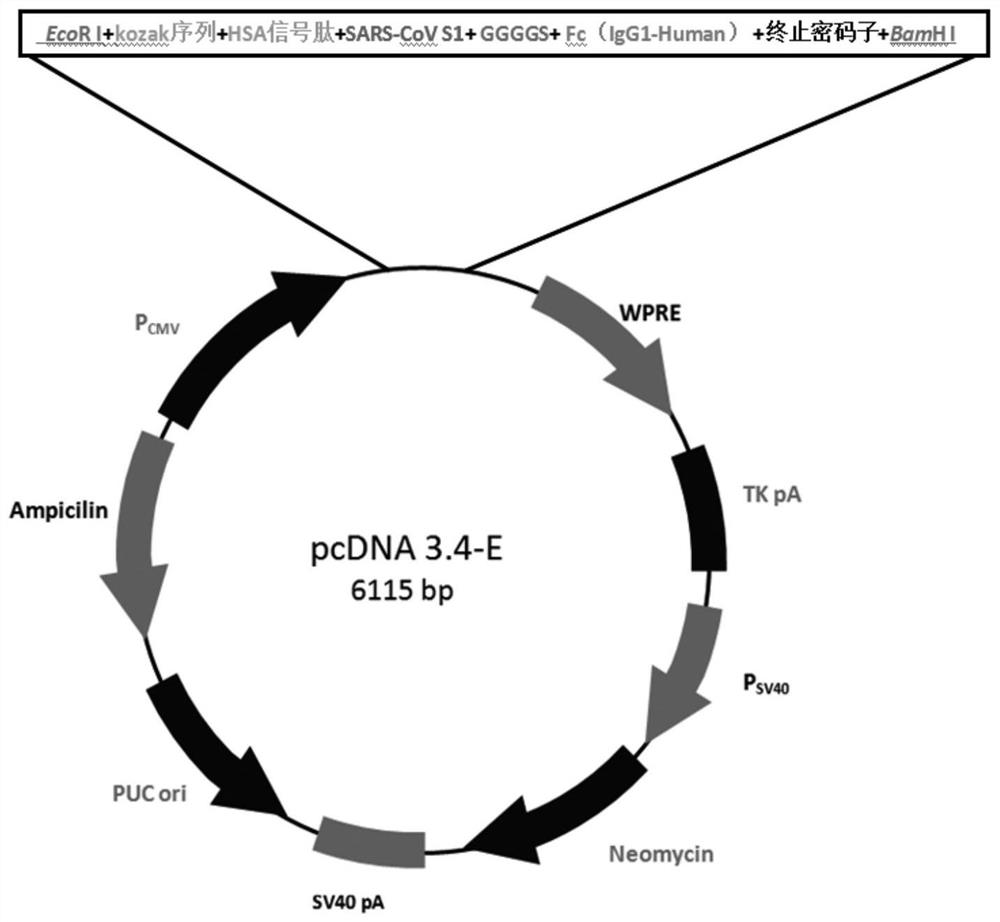Method and test strip for evaluating cross-species infection risk of coronavirus and application of test strip
A coronavirus and cross-species technology, which is applied in the direction of biological material analysis, analysis by making materials undergo chemical reactions, and material analysis by observing the impact on chemical indicators, etc., can solve the problem of inability to popularize and cross-species infection experiments , complex steps and other issues, to avoid the spread and leakage of viruses, lower the threshold of professionalism and conditions, and facilitate on-site operations
- Summary
- Abstract
- Description
- Claims
- Application Information
AI Technical Summary
Problems solved by technology
Method used
Image
Examples
Embodiment 1
[0047] (1) Gene synthesis
[0048] Taking a polypeptide comprising the RBD region of the SARS-CoV spike protein (SARS-CoV S1) and a polypeptide comprising the RBD region of the SARS-CoV-2 spike protein (SARS-CoV-2S1) as an example, the following test is carried out, wherein , the amino acid sequences of SARS-CoV S1 and SARS-CoV-2S1 are shown as SEQ ID No 1 and SEQ ID No 2 respectively (sequence source: GenBank No: AAX16192.1 and NC_045512).
[0049] (1) Optimize the amino acid sequences (SEQ ID No 1 and SEQ ID No 2) of SARS-CoV S1 and SARS-CoV-2S1, wherein the C-terminal is the linkage sequence "GGGGS" + human Fc affinity tag, and the N-terminal Add the signal peptide of human serum albumin to obtain SEQ ID No 3 and SEQ ID No 4;
[0050] (2) On the basis of SEQ ID No 3 and SEQ ID No 4, further design restriction sites at both ends of the sequence, and add the kozak sequence "GCCACC" before the signal peptide to obtain SEQ ID No 5 and SEQ ID No 6, Then the sequencing after sy...
Embodiment 2
[0087] Example 2 Preparation of a test panel that can qualitatively assess the risk of the coronavirus being tested for infecting humans through ACE2
[0088] (1) Preparation of colloidal gold
[0089] Get 100mg of chloroauric acid and dissolve it in 1000ml of three-distilled water, add 15ml of trisodium citrate with a concentration of 1% (mass percentage), boil for 15 minutes, and obtain a colloidal gold solution of 15-50 nanometers after cooling;
[0090] (2) Colloidal gold labeling of streptavidin
[0091] Take two 1.5mL centrifuge tubes and wash them twice with ultrapure water, absorb 1mL colloidal gold and add to each tube, add 4μL of 0.2M potassium carbonate to each tube, add 20μg streptavidin to the tubes, mix well and react for 10min. Add 40 μL of blocking solution to each tube to react for 10 min, and centrifuge at 11000 r / min for 20 min. The supernatant was discarded, and the precipitate was reconstituted with 500 μL gold reconstitution solution (20 mM tris, 1% BSA...
Embodiment 3
[0099] Example 3: Risk Assessment (Example)
[0100] Risk assessment of people infected with the virus to be tested
[0101] Mix the solutions containing 1 μg of BSA, SARS-CoV S1 and SARS-CoV-2S1 proteins with 1 portion of 50 μL diluted human ACE2PD-Biotin probe solution, add dropwise to the sample pad of the detection plate, and wait for 5-15 minutes Finally, observe the inspection line and quality inspection line. The results showed that color bands appeared on the quality inspection lines of the three test boards, which proved that their risk assessment results were all valid; since there were color bands on the test lines on the test board where BSA was added, there was no risk in evaluating BSA; Since there is no color band on the test line on the test plate where SARS-CoV S1 and SARS-CoV-2 S1 proteins are added dropwise, the evaluation of SARS-CoV and SARS-CoV-2 is high risk ( Image 6 ).
PUM
 Login to View More
Login to View More Abstract
Description
Claims
Application Information
 Login to View More
Login to View More - R&D
- Intellectual Property
- Life Sciences
- Materials
- Tech Scout
- Unparalleled Data Quality
- Higher Quality Content
- 60% Fewer Hallucinations
Browse by: Latest US Patents, China's latest patents, Technical Efficacy Thesaurus, Application Domain, Technology Topic, Popular Technical Reports.
© 2025 PatSnap. All rights reserved.Legal|Privacy policy|Modern Slavery Act Transparency Statement|Sitemap|About US| Contact US: help@patsnap.com



